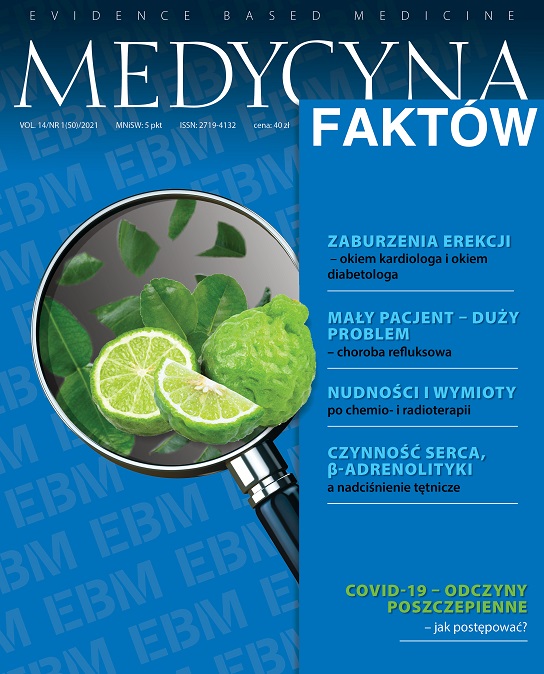Ten reasons to use fosfomycin trometamol in daily practice Review article
Main Article Content
Abstract
Urinary tract infections are one of the most common diseases among women. At least 50% of women will develop at least one of urinary tract infection episode during life-time. It should be also underlined that more than one-fourth of them will also develop recurrence within the half year following the initial infection and therapy. The empirical treatment of urinary tract infections should include susceptibility data based on local antimicrobial resistance rates. The effective initial treatment can be considered as an effective preventive strategy of the rapidly increasing bacterial resistance to antibiotics. Fosfomycin trometamol is a safe and highly effective antimicrobial drug which can be used in a single dose in the treatment of uncomplicated urinary tract infections.
Article Details
Copyright © by Medical Education. All rights reserved.
References
2. Miotla P, Romanek-Piva K, Bogusiewicz M et al. Antimicrobial Resistance Patterns in Women with Positive Urine Culture: Does Menopausal Status Make a Significant Difference? Biomed Res Int. 2017; 2017: 4192908.
3. Naber KG, Wullt B, Wagenlehner FM. Antibiotic treatment of uncomplicated urinary tract infection in premenopausal women. Int J Antimicrob Agents. 2011; 38(suppl): 21-35.
4. American College of Obstetricians and Gynecologists. ACOG Practice Bulletin No. 91: Treatment of urinary tract infections in nonpregnant women. Obstet Gynecol. 2008; 111(3): 785-94.
5. Waller TA, Pantin SAL, Yenior AL et al. Urinary Tract Infection Antibiotic Resistance in the United States. Prim Care. 2018; 45(3): 455-66.
6. Hendlin D, Stapley EO, Jackson M et al. Phosphonomycin, a new antibiotic produced by strains of Streptomyces. Science. 1969; 166(3901): 122-3. http://doi.org/10.1126/science.166.3901.122.
7. Takahata S, Ida T, Hiraishi T et al. Molecular mechanisms of Fosfomycin resistance in clinical isolates of Escherichia coli. Int J Antimicrob Agents. 2010; 35(4): 333-7.
8. Zhanel GG, Walkty AJ, Karlowsky JA. Fosfomycin: A First-Line Oral Therapy for Acute Uncomplicated Cystitis. Can J Infect Dis Med Microbiol. 2016; 2016: 2082693.
9. Kahlmeter G. The ECO.SENS Project: A prospective, multinational, multicentre epidemiological survey of the prevalence and antimicrobial susceptibility of urinary tract pathogens – interim report. J Antimicrob Chemother. 2000; 46(suppl 1): 15-22.
10. Karageorgopoulos DE, Wang R, Yu XH et al. Fosfomycin: Evaluation of the published evidence on the emergence of antimicrobial resistance in Gram-negative pathogens. J Antimicrob Chemother. 2012; 67(2): 255-68.
11. Sánchez-García JM, Sorlózano-Puerto A, Navarro-Marí JM et al. Evolution of the antibiotic-resistance of microorganisms causing urinary tract infections: A 4-year epidemiological surveillance study in a hospital population. Rev Clin Esp. 2019; 219(3): 116-23.
12. Janknegt R, Hooymans PM, Fabius GT et al. Urinary concentrations of fosfomycin after a single 3 g dose of fosfomycin to elderly nursing-home patients. Pharm World Sci. 1994; 16(3): 149-53.
13. Charakterystyka produktu leczniczego Monural, 3 g, granulat do sporządzenia roztworu doustnego, zatwierdzona 24.09.2020 (access: 10.12.2020).
14. Kuiper SG, Dijkmans AC, Wilms EB et al. Pharmacokinetics of fosfomycin in patients with prophylactic treatment for recurrent Escherichia coli urinary tract infection. J Antimicrob Chemother. 2020; 75(11): 3278-85.
15. Mittal S, Sharma M, Chaudhary U. Fosfomycin use in multi drug resistant uropathogenic Escherichia coli. Infect Disord Drug Targets. 2015; 15(3): 196-201.
16. Seroy JT, Grim SA, Reid GE et al. Treatment of MDR urinary tract infections with oral fosfomycin: a retrospective analysis. J Antimicrob Chemother. 2016; 71(9): 2563-8.
17. Albán V, Mariño-Brito E, Villavicencio F et al. Fosfomycin, Applying Known Methods and Remedies to A New Era. Diseases. 2020; 8(3): 31. http://doi.org/10.3390/diseases8030031.
18. Aprile A, Scalia G, Stefani S et al. In vitro fosfomycin study on concordance of susceptibility testing methods against ESBL and carbapenem-resistant Enterobacteriaceae. J Glob Antimicrob Resist. 2020; 23: 286-9.
19. Skarżyńska M, Zając M, Wasyl D. Antybiotyki i bakterie: mechanizmy działania i strategie oporności. Postępy Mikrobiologii – Advancements of Microbiology. 2020; 59(1): 49-62.
20. Ito R, Tomich AD, McElheny CL et al. Inhibition of Fosfomycin Resistance Protein FosA by Phosphonoformate (Foscarnet) in Multidrug-Resistant Gram-Negative Pathogens. Antimicrob Agents Chemother. 2017; 61(12): e01424-17. http://doi.org/10.1128/AAC.01424-17.
21. Rodríguez-Lozano J, de Malet A, Cano ME et al. Antimicrobial susceptibility of microorganisms that cause urinary tract infections in pediatric patients. Enferm Infecc Microbiol Clin. 2018; 36(7): 417-22.
22.EAU. Urological Infections (access: 4.12.2020)
23. Hryniewicz W, Holecki M (ed). Rekomendacje diagnostyki, terapii i profilaktyki zakażeń układu moczowego u dorosłych. Narodowy Instytut Leków, Warszawa 2015.
24. Cai T, Palagin I, Brunelli R et al. Office-based approach to urinary tract infections in 50 000 patients: results from the REWIND study. Int J Antimicrob Agents. 2020; 56(1): 105966.
25. Gilstrap LC 3rd, Ramin SM. Urinary tract infections during pregnancy. Obstet Gynecol Clin North Am. 2001; 28(3): 581-91.
26.Falagas ME, Vouloumanou EK, Samonis G et al. Fosfomycin. Clin Microbiol Rev. 2016; 29(2): 321-47. http://doi.org/10.1128/CMR.00068-15.
27. Chu C, Lowder J. Diagnosis and treatment of urinary tract infections across age groups. Am J Obstet Gynecol. 2018; 219(1): 40-51.
28. Nicolle LE, Gupta K, Bradley SF et al. Clinical Practice Guideline for the Management of Asymptomatic Bacteriuria: 2019 Update by the Infectious Diseases Society of America. Clin Infect Dis. 2019; 68(10): e83-e110. http://doi.org/10.1093/cid/ciy1121.
29. Smaill FM, Vazquez JC. Antibiotics for asymptomatic bacteriuria in pregnancy. Cochrane Database Syst Rev. 2019; 11: CD000490. https://doi.org/10.1002/14651858.CD000490.pub4.
30. Romero R, Oyarzun E, Mazor M et al. Meta-analysis of the relationship between asymptomatic bacteriuria and preterm delivery/low birth weight. Obstet Gynecol. 1989; 73(4): 576-82.
31. Minassian C, Thomas SL, Williams DJ et al. Acute maternal infection and risk of pre-eclampsia: a population-based case-control study. PLoS One. 2013; 8(9): e73047.
32. Henderson JT, Webber EM, Bean SI; Rockville (MD): Agency for Healthcare Research and Quality (US). Screening for Asymptomatic Bacteriuria in Adults: An Updated Systematic Review for the U.S. Preventive Services Task Force. [Internet]. 2019 Sep. Report No.: 19-05252-EF-1.
33. Cartwright R, Miotla P. Pinning down the evidence for acupuncture for recurrent urinary tract infection. BJOG. 2020; 127(12): 1469.

